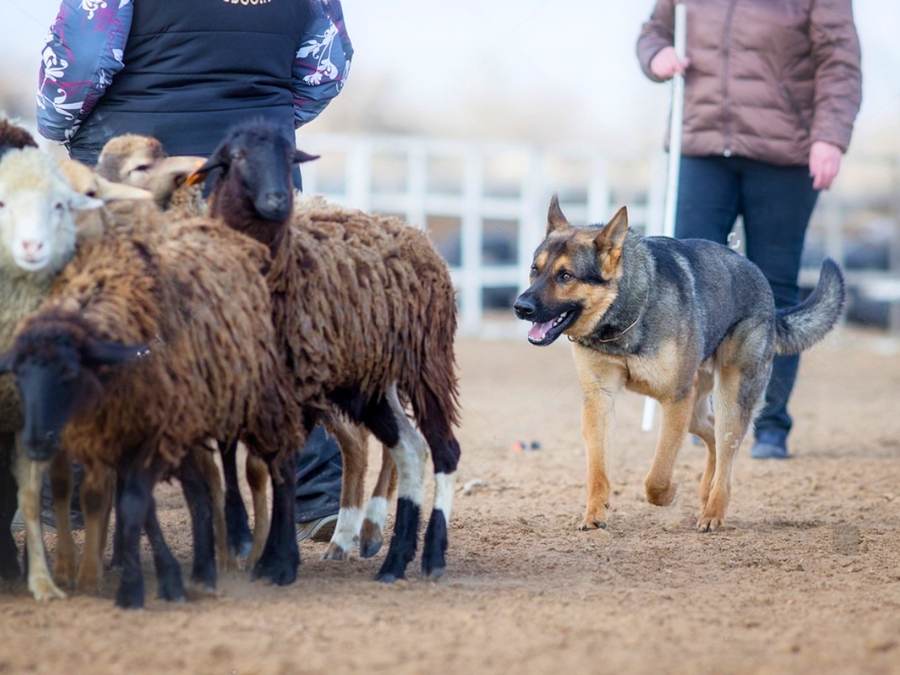Originating from Germany in the late 19th century, German Shepherds were meticulously bred to excel in herding sheep and protecting flocks from predators.
Today, while many German Shepherds have transitioned from pastoral fields to diverse roles such as law enforcement, and loyal companionship, their herding roots remain a pivotal aspect of their character.
This instinct shapes much of their behavior, from their protective nature to the way they interact with their human families.
What Causes German Shepherd’s Herding Behavior?
The herding behavior in German Shepherds is a complex, multifaceted behavior pattern deeply ingrained in the breed’s DNA. This instinct is characterized by a natural drive to gather, guide, and protect livestock.
Max von Stephanitz, (a captain in the German cavalry and the father of the GSD breed) designed German Shepherds (through selective breeding) to be the ultimate shepherd’s companion, capable of not only guiding and protecting the flock of sheep but also making independent decisions in the absence of direct commands.
Today’s German Shepherds might not all find themselves in fields herding sheep, but their herding behavior manifests in various ways.
Whether it’s rounding up children or other pets in the yard, organizing toys, or patrolling the boundaries of their home, the essence of their herding heritage is ever-present.

Common German Shepherd Herding Behaviors
Here’s a closer look at the common herding behaviors and signs in German Shepherds and how they might manifest in everyday scenarios.
- Circling: One of the most distinctive herding behaviors is circling, where the dog moves in a circular pattern around their “flock.” While originally meant to keep sheep together, in a home environment, this might involve circling family members during outdoor activities or play.
- Nudging: German Shepherds may use their noses to gently push against people or other pets to guide them in a certain direction, mimicking the way they would maneuver sheep.
- Chasing: The instinct to chase moving objects, including cars, bicycles, or running children, stems from the herding instinct to keep moving targets within a controlled area.
- Barking: While herding, barking serves as a tool for communication and control, directing the movement of the flock. At home, German Shepherds may bark to command attention or influence the behavior of others.
- Stalking: The breed may display stalking behavior, moving slowly and deliberately towards an object of interest, similar to how they would approach wayward sheep.
- Eyeing: Known as “the eye,” this behavior involves the dog fixing a steady, intense gaze on those they wish to control, a tactic used in herding to assert dominance and direct movement without physical contact.
How Do These Herding Behaviors Manifest in Everyday Situations
These herding behaviors, while natural and often harmless, can sometimes pose challenges in everyday life. For instance:
- Circling and chasing: During playtime or walks, a German Shepherd might circle or chase children, cyclists, other pets, or joggers, misinterpreting their movements as a cue to herd. While not aggressive, this behavior can be problematic and potentially dangerous.
- Nudging: While often gentle, nudging can be persistent, especially if the dog is trying to “herd” a person to a particular location or action.
- Barking and stalking: These behaviors can be misinterpreted as aggression, especially in social settings.
- High energy levels: Their natural drive and stamina, while excellent for herding, mean they require a lot of exercise and mental stimulation to prevent boredom and destructive behaviors.
- Overprotectiveness: Their instinct to protect the flock can translate into overprotectiveness of their family or territory, leading to issues with guests or when in public spaces.
By acknowledging the root of these behaviors, GSD owners like us can better navigate training and socialization, ensuring these instincts are expressed in safe, controlled ways that honor their heritage while fitting into a modern lifestyle.

Strategies for Managing Herding Behaviors
Here are several effective strategies to positively direct your German Shepherd’s herding instincts:
1. Structured Exercise and Play
- Engage in herding-specific activities: Enroll your dog in herding trials or training courses. These are designed to channel the herding instinct in a controlled environment and are an excellent way for your dog to engage in natural behaviors safely.
- Interactive toys: Use toys that mimic the movement of animals, such as remote-controlled toys or balls, to satisfy the chase aspect of herding. Puzzle toys can also stimulate their problem-solving skills, keeping their minds engaged.
2. Obedience Training
- Basic commands: Teach your German Shepherd basic commands like “sit,” “stay,” “come,” and “leave it.” This foundation is crucial for managing their behavior in situations where their herding instincts might be inappropriate.
- Impulse control exercises: Training your dog to control their impulses, such as waiting for permission before eating or fetching, can help manage the instinct to chase or herd without command.
3. Socialization
- Expose to various environments: Gradually introduce your German Shepherd to different settings, people, and animals. Socialization helps them learn appropriate behaviors and reduces overstimulation in situations that might trigger their herding instincts.
- Playdates with other dogs: Allowing your German Shepherd to interact with other dogs under supervision can help them learn how to play without resorting to herding behavior.
4. Mental Stimulation
- Training for new skills: Continuously teaching your dog new commands or tricks keeps their mind active and reduces the likelihood of boredom, which can lead to unwanted herding behavior.
- Agility training: Agility courses mimic some of the mental and physical challenges of herding by requiring your dog to navigate obstacles, follow commands, and focus on tasks.
5. Professional Guidance
- Consult with a dog trainer: A professional dog trainer with experience in working breeds can provide personalized strategies to manage and channel your German Shepherd’s herding instincts.
- Behavioral modification programs: For dogs that display overly enthusiastic herding behavior, a tailored behavioral modification program can help. These programs focus on redirecting undesired behaviors into more appropriate outlets.
6. Routine and Consistency
- Establish a routine: Consistent routines for exercise, play, and training help manage energy levels and reduce anxiety, which can exacerbate herding behaviors.
- Consistent commands and rules: Everyone in the household should use the same commands and adhere to the same rules to avoid confusing your dog.
These strategies not only prevent the development of problematic behaviors but also enrich your dog’s life, strengthening your bond and ensuring they are healthy, happy, and well-adjusted members of your family.

Activities That Fulfill a GSD’s Herding Instincts
To cater to the herding instinct of German Shepherds while ensuring they remain mentally stimulated and physically active, it’s essential to integrate these physical and mental exercises into their routine.
Physical Exercises
- Herding balls: Large, durable balls designed for dogs to push around (often called herding balls or Treibball) mimic the experience of herding. These balls encourage your German Shepherd to use their body and instincts to move the ball, providing a physical outlet for their herding drive.
- Agility training: Agility courses simulate the physical maneuvers dogs perform while herding, such as weaving, jumping, and running through obstacles.
- Frisbee or fetch: Playing fetch or Frisbee can satisfy the chase aspect of the herding instinct.
- Hiking and outdoor adventures: Taking your German Shepherd on hikes or outdoor adventures allows them to navigate different terrains and environments, keeping their minds and bodies engaged.
RELATED: How Much Exercise Does a German Shepherd Need?
Mental Exercises
- Obedience training: Regular obedience training sessions challenge your German Shepherd’s mind. Teaching them new commands or tricks keeps their brain active, reducing boredom and destructive behaviors.
- Puzzle toys and games: Puzzle toys that require your dog to solve problems to receive a reward can significantly stimulate their intellect. These toys mimic the mental challenges they would face while working and herding.
- Hide and seek: Playing hide and seek with your German Shepherd encourages them to use their senses and problem-solving skills. Hide treats or toys around your home or yard for them to find, or hide yourself and call them to you.
- Scent work: Scent work exercises, where dogs are trained to identify and locate a specific scent, can be incredibly mentally stimulating. This activity leverages their natural tracking instincts, which are part of the broader set of skills used in herding.
By integrating these physical and mental exercises into your German Shepherd’s routine, you can effectively cater to their herding instinct, ensuring they remain healthy, happy, and well-balanced.

Frequently Asked Questions
1. Are German Shepherds still used for herding?
Yes, German Shepherds are still used for herding in some areas. In rural settings and on farms, German Shepherds are employed to manage and protect livestock, including sheep and cattle. Their intelligence, trainability, and natural herding abilities make them well-suited for this work, though it is less common than it once was.
2. How to stop a German Shepherd from herding?
To stop a German Shepherd from herding, it’s essential to channel their instincts through appropriate training and activities. Begin with reinforcing basic obedience commands like “sit,” “stay,” and “come” to establish control and focus.
Utilize distraction techniques by engaging your dog in alternative exercises or play that satisfy their need for mental and physical activity, such as fetching, agility courses, or puzzle toys.
Ensuring your German Shepherd receives ample exercise can significantly reduce unwanted herding behavior by constructively expending energy.
3. Is my German Shepherd herding me?
If your German Shepherd exhibits behaviors such as circling around you, gently nudging you in a specific direction, or trying to control your movements with their body, it’s likely they are displaying herding behavior towards you.
This behavior is a manifestation of their natural instinct and is not typically a sign of aggression.
4. Can German Shepherds herd chickens?
German Shepherds can be trained to herd chickens, but it requires careful training and supervision. Chickens are much more fragile than sheep or cattle, and the herding behavior needs to be controlled to ensure the birds are not harmed.
It’s important to gradually introduce the dog to the chickens, teach them gentle herding techniques, and closely monitor their interactions to prevent any accidents.
Final Remarks
While your German Shepherd’s herding behavior presents unique challenges, understanding and properly managing it can turn potential issues into advantages. By engaging in activities that fulfill their physical and mental needs, providing structured training, and ensuring they have appropriate outlets for their herding behavior, owners can enjoy the many benefits of living with these intelligent, loyal, and capable companions.




